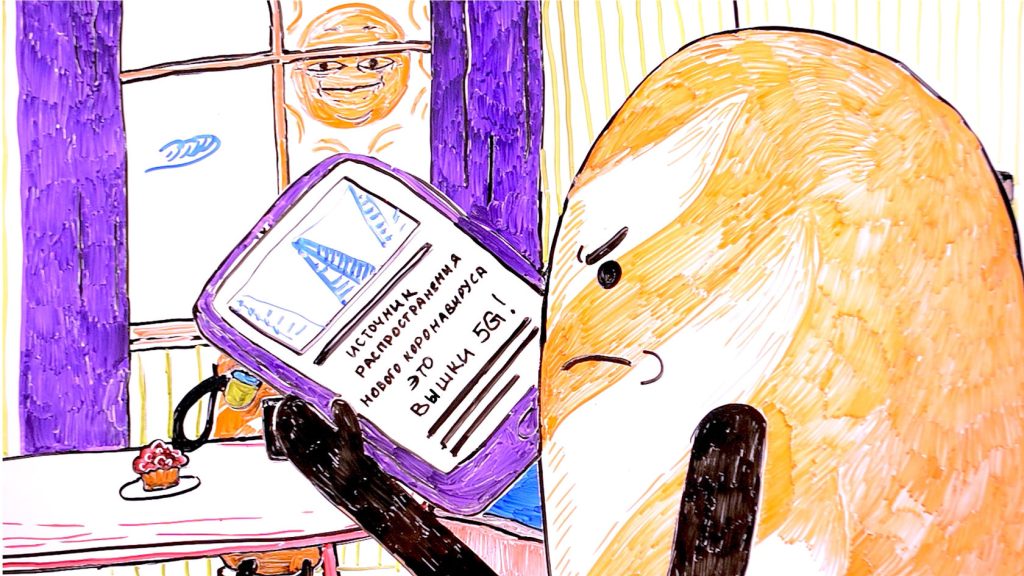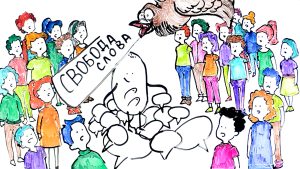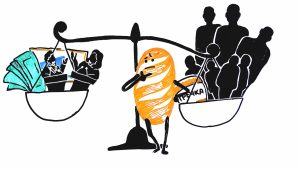We live in an age of rapid development of new media formats and media technologies. Today, it is important for all of us to be able to consume information consciously and to have the skills to create media content – to be a media literate person.
Professor Alexander Fedorov, author of textbooks on media education, defines media literacy as “the ability to perceive, analyze, and synthesize spatial and temporal reality – to ‘read’ media text”. The term “media and informational literacy” refers to the basic characteristics (knowledge, skills, and abilities) that allow citizens to interact effectively with media and other information services and to develop critical thinking and lifelong learning skills – to communicate and implement active civic positions. Media and information literacy involves the ability to work with any source of information (oral and written; analog and electronic/digital) and with all types and formats of information sources.
In addition to the definition of “media and information literacy”, the UNESCO suggests using the term “digital literacy”. Digital literacy is the ability to use digital technologies to locate, evaluate, use and create information; the ability to use information from a variety of sources and to solve problems effectively in an electronic environment. Digital literacy includes the ability to read and interpret digital media, to reproduce data and images using electronic devices, and to evaluate and apply new knowledge gained from the electronic environment. Projects aimed at improving all types of media literacy are now being actively developed in UNESCO member countries. Media literacy textbooks in various languages can be downloaded free of charge from the UNESCO website.
In Germany, media literacy classes are taught in schools. For a long time they were limited to the development of media production skills: making a film or creating a presentation. Recently, however, more and more attention has been paid to the development of critical media consumption. The Center for Media and Information Literacy at the Freie Universität Berlin, for example, is engaged in such projects. The Federal Center for Civic Education has created a database of projects with sites on various aspects of media literacy. For example, if you search for videos on the topic of social media conduct, the database shows six sites, both federal and state-specific. Among them are a German police website with materials on how not to become a victim of crime online, a handbook for parents on how to control the content their children consume on social media, and educational and entertaining materials for children.
The German NGO n-ost, with the participation of experts from several Eastern European countries, including Russia and Ukraine, has developed Media Navigator – an online collection of engaging exercises in Russian that can be used both for independent work and for media literacy training. On the site you can find exercises on identifying fakes, assignments on writing news from the point of view of different characters from the same tale, an unexpected version of the game “Broken Telephone” and much more.
In Russia, the Center for Digital Cultures and Media Literacy at the Higher School of Economics is actively and successfully engaged in media literacy projects. Since 2016 HSE has been holding news literacy schools in different regions of Russia, which are open to interested students from any university. One of the recent Russian projects on media literacy is the portal “How to Read Media” with the provocative caption “The Earth is flat”, created by the Goethe Institute in Moscow. Here one can find short videos on topics related to media consumption and digital culture, as well as many useful links.
Ukraine today has one of the most developed media-education systems in Europe. Over the past few years, dozens of major projects have been initiated, and lessons on media education have already become a common thing in Ukrainian schools. One of the leading portals, which is engaged in both media quality monitoring and educational programs, is “Detector Media“. The “StopFake” website exposes fake news and also offers manuals on how to develop skills to identify fakes on your own. The Ukrainian team of the international organization IREX created a captivating media literacy game in Ukrainian and English. The plot is that a certain city has been flooded with fake news, and the participants of the game need to identify them in order to save the city.
Why do we need to increase media literacy?
The term “post-truth” was the word of the year 2016 according to the Oxford Dictionary.
The adjective is defined as “relating to or denoting circumstances in which objective facts are less influential in shaping public opinion than appeals to emotion and personal belief”, the dictionary writers explained their choice. In other words, people are more inclined to believe not what is confirmed by facts, but what corresponds to their beliefs and perceptions of the world. In the era of “post-truth”, political culture increasingly relies on emotional arguments instead of facts and evidence. This situation is also reflected in the media.
The personal beliefs of citizens are increasingly becoming an important factor in the political process. The phenomenon of post-truth began to be discussed in 2015-2016 in the context of Donald Trump’s election campaign in the United States, as well as the referendum on Britain’s exit from the European Union. The term is most often used to describe presidential candidate Donald Trump’s communications with his supporters. From the beginning of his campaign, Trump made a number of controversial statements, which were later refuted by his opponents and journalists relying on facts. However, thanks to the emotional appeal, Trump’s version continued to circulate in the media space and influence voter perceptions.
Fake news – unreliable, false, distorted or incomplete information disseminated in the media – have become another challenge in today’s media landscape. Fake news are often defined as any unreliable information, even if it has been distorted by mistake. However, the most dangerous for public communication are fake news, where the authors deliberately misinform the audience. Fakes are emotional and built on stories that work with basic human attitudes and needs. U.S. President Donald Trump even established an award for the most unreliable news – the Fake News Awards.
It is a known fact that disinformation disguised as news was used during the 2016 and 2017 elections in the U.S., France and Germany. An even more illustrative case occurred in 2017 in Mexico: Social media users around the world watched in real time as rescuers tried to free schoolgirl Frida Sofia, who was trapped under rubble after an earthquake. A few days later, however, authorities were forced to admit that the girl did not really exist. Computer technology has been used for disinformation – editing audio recordings, photo editing, and neural network techniques like DeepFake, which create fake videos with plausible imitations of images of famous people.
Another type of manipulative communication online is hate speech. According to the OSCE definition, hate speech means various types of statements that are based on hostility and demonstrate or incite hatred toward a group or an individual because of their affiliation with a particular group. Such statements may contain stereotypes, prejudices, and signs of discrimination. The most popular topics in the context of which examples of the use of “hate speech” can be found are religious and ethnic conflicts and migration issues. Filmmaker Xenia Hrabrykh has compiled common examples of the use of hate speech in a short film. And this booklet details examples of hate speech and ways to combat it.
In order to be able to identify these and other manipulative techniques, one must improve one’s own media literacy.
How to develop media literacy?
One of the core competencies of a media literate person is the ability to think critically. According to the UNESCO definition, critical thinking is the ability to examine and analyze information and ideas for the purpose of understanding and evaluation, rather than simply accepting all suggestions for granted. Critical thinking is considered one of the “soft skills” that should be developed regardless of the field of professional activity. According to Renira Rampazzo Gambarato, PhD, lecturer at the Department of Communications, Media and Design at the Higher School of Economics, “to be critical of media content means to perceive content using critical thinking in order to analyze the quality, credibility, reliability and perspective of a particular message, taking into account the influence of media content. In order to cope with large amounts of information, one must be selective”.
The main tools of a critical and media literate person are fact-checking and data verification, or the ability to verify facts, digital content and sources. To navigate the media landscape, UNESCO media experts recommend the following set of rules:
- Seek primary sources of information or confirmation of information from several sources independent of each other;
- Carefully study statistical data (research methods, representativeness of the survey sample), because figures can become subject to various manipulations;
- Use with caution the data published in social networks: you can check the account of the author of the message, their activity, search for accounts in other social networks – such analysis allows you to find out if the account belongs to a real person or a “bot“;
- Check photo and video images if you have doubts about their authenticity: analyze the date of publication and metadata (the EXIF file of the photo), check GPS coordinates of the place where the photos were created and compare them with the data in the text; reverse search using a special Google tool that shows where and when the image was published; use image analysis tools for traces of processing and editing (TinEye and similar);
- Search for specific fact-checking methods for your case: For example, there are online-services that store weather data for almost any place on the globe, where you can check if a hurricane or tsunami really happened in the specified place. Here you can read more in English and Ukrainian about some methods of verification.
How to verify a politician’s statement?
The most important tools for our course are those for verifying the statements of political actors. Media literacy helps citizens make the right decision about who to vote for in an election. A politician’s statements can be verified with a few simple steps:
Determine if the statement purports to be a fact.
If a statement you see on television or the internet seems wrong, ask yourself if it is a factual statement. Opinion and rhetoric have their place in public debate, as does satire. You cannot verify opinion, and it is useless to complain about satire (unless, of course, it is hate speech). Claims of factual relevance are rather easy to detect. Sometimes they contain tangible nouns (employment, health care, infrastructure), figures, and comparisons (my administration/country works better/worse than yours). They also contain statements about what the politician has achieved or the state the city/country is in because of them. Promises or statements about the future cannot be verified.
Decide whether the claim makes a difference.
You have identified claims in the text that purport to have the status of fact. Before you spend time verifying them, ask yourself whether it would really affect you or society at large if people believed the claim. If so, move on to verification.
Ask for evidence from the politician himself. If the politician does not respond, try to find evidence to support his claim.
Whether you are a member of the public or a journalist, you have the right to ask a politician for proof. Most politicians have websites and Twitter feeds, so it’s easy to get in touch with them. If they don’t respond, look for evidence yourself.
When you find evidence, examine it.
If a politician gives you evidence, check it out. Do the facts really show what the politician is saying? Read the evidence in its entirety. Do not take at face value any idea that supports a claim of fact.
When was the information gathered? Remember, it’s a beloved trick to carefully choose a start and end date for the data to make the numbers look good. Zoom out to look at a longer-term trend.
Who is providing the information? What do you know about the source of the data? Are they trustworthy? How was the information collected? If it is a survey, how many people were interviewed, and by whom?
Is the data complete? A small, localized survey will not necessarily tell you much about the situation in the country, and vice versa.
Has the evidence been verified by others? Scientists rely on “peer review” to verify their findings and discoveries. Has the evidence been published and verified by other credible sources?
Think about the context
Ask yourself what this claim of fact excludes or masks. A politician who says that there has been weak economic growth throughout their opponent’s term may mislead readers by not mentioning that their opponent inherited a recession when they took office. A common ploy is to demand recognition for what was the work of others. If a politician takes credit for economic growth in their first weeks in office, this is misleading. Likewise, a politician can be misleading by, for example, complaining about an increase in crime and not noticing that the population has also grown.
Find reliable sources to verify the fact.
Depending on your country, the hardest part of fact-checking may be finding reliable sources of information. Depending on the type of claim you are verifying, the best sources may be government documents and official statistics, company reports, academic studies or think tank publications. There is no single guide to finding reliable sources, but here are some basic rules for fact-checking: Don’t rely on just one source; find several sources that are independent of each other; check their methodology and funding sources.
Understand why anyone would believe that.
If you want to write somewhere about your dissatisfaction with a claim of fact, don’t pick on it. If the judgment deviates slightly from the facts, put it in the “mostly correct” category. No one is perfect. Don’t say someone is lying unless you have proof that they know their claim is wrong. Politicians may not know something. Try to understand why anyone else would believe that claim, and what difference it makes.
Accept that you will have critics.
It is important to remember that you will be criticized. Many studies show that people of all political persuasions often do not respond to evidence that contradicts what they think is right.
Try applying these tips to a speech by a president or head of government. With the tools of media literacy, it is much easier to distinguish facts from manipulation and to make decisions important to a citizen of a democratic state – to elect politicians, to demand an account of their activities, or to dismiss them.





